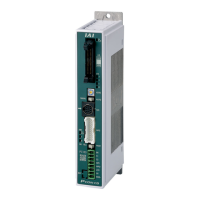4. Operation
4.3 Pulse Train Control Mode
4-114
ME0342-4B
Caution
● These signals become effective after the coordinate system is established following
home return. Turning on the power is not enough to output these signals.
● These signals are not available if the home return function of the controller is not used.
● The zone detection range would not turn ON unless the value exceeds that of the
minimum resolution (actuator lead length/800).
[9] Alarm, Alarm Reset (*ALM, RES)
PIO signal
1) Alarm signal *ALM is set to ON in the normal status but turned OFF at the occurrence of an
alarm at a level equal to or higher than the operation release level.
2) Turning reset signal RES ON under occurrence of an alarm at the operation release level
allows the alarm
(Note 1)
to be released. The action is taken at the rising edge (ON edge).
3) The alarm reset should be done after the cause of the alarm is confirmed and removed. If
alarm reset and restart are repeated many times without removal of the cause, a severe
failure such as motor burnout may occur.
Note 1 Refer to [8.3.3 Alarm Details] for details of alarms.
Caution
● An alarm of the cold start level cannot be cancelled by RES. Confirm the cause,
remove it, and then reboot the unit.
[10] Binary Output of Alarm Data Output (*ALM, PM1~8)
PIO signal
1) If an alarm at a level equal to or higher than the operation release level occurs, completed
position number output signals PM1 to PM8 output the alarm information in the binary code
format.
2) The PLC can read the binary code of alarm signal *ALM as the strobe signal to check the
alarm information.
Refer to [8.3.1 Simple Alarm Codes] for details of the binary codes.
4.3 Pulse Train Control Mode
ME0342-4B 4-115
[11] Brake Release (BKRL)
PIO signal
The brake can be released while BKRL signal is turned ON. For the actuator equipped with a
brake, the brake can be controlled by turning the servo ON/OFF, however, a release of the
brake may be necessary in the case of installing the unit to a system so the slider or rod can be
moved by hand.
This operation can be performed not only by the brake release switch on the front panel of the
controller, but also by the brake release signal BKRL.
Caution
● Take sufficient care to release the brake. Inappropriate brake release may cause
people to be injured and/or the actuator, the work and/or the machine to be damaged.
● After the brake is released, always make the brake applied again. Any operation with
the brake remaining released is extremely dangerous. The slider or rod may drop to
cause people to be injured and/or the actuator, the work and/or the machine to be
damaged.
● Make certain that this signal is turned OFF (brake is activated) when the power is
supplied to the controller.
● It is prohibited to switch over between AUTO and MANU while this signal is ON
(brake is released).

